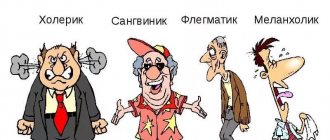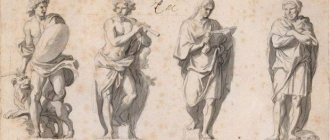The topic to which this article is devoted has been of concern to the global scientific community for several decades - it is directly related to the individual personal characteristics of people.
Everyone knows that the psyche of each person is unique. And this is connected both with the physical and biological characteristics of the organism, and with a complex of social characteristics. If we talk about biologically determined substructures, then, mainly, we need to consider temperament.
What is temperament?
Temperament implies the mental differences of people, which include the depth, intensity and stability of emotions, energy and pace of actions, emotional sensitivity and many other features of mental life. And the problem of temperament today remains controversial and unresolved. But even if we take into account all the diversity of approaches to its study, researchers agree that temperament is the biological foundation on which a person’s personality as a social being is based.
Temperament is a reflection of the dynamic aspects of behavior, which are mainly innate. Its properties are more stable than the properties of other mental characteristics of a person. And its most striking nuance is that the properties of the temperament of one particular person are not combined with each other by chance - they are interconnected naturally and form a certain conglomerate that characterizes the temperament.
To summarize: temperament must be considered as individually unique properties of the psyche that determine the dynamics of an individual’s mental activity; manifested equally in various activities, regardless of its motives, goals and content, and remaining unchanged already in adulthood, and also characterizing in the aggregate the type of temperament.
However, before considering the types of temperament and their features, it should be said that temperament cannot be bad or good, because Each type has its own advantages, and the efforts of any person should be aimed not at correcting its shortcomings, but at effectively applying its advantages in everyday life and activities.
Creation of typologies of temperament
Since ancient times, people have strived to understand and identify the typical mental characteristics of different people and unite them into a small number of generalizing models. It was these models that were called temperament types; moreover, they were very practical, because through them it was possible to predict the behavior of a person with a certain type of temperament in a specific life situation.
It is officially believed that the doctrine of temperament in general was created by the ancient Greek physician Hippocrates, who argued that people are distinguished by four main “body juices” - blood, phlegm, yellow bile and black bile. Following the teachings of Hippocrates, the equally famous physician of antiquity, Claudius Galen, created the first typology of temperaments of its kind and outlined it in his treatise “De Temperamentum”. According to his ideas, the type of temperament depends on what type of “juice” predominates in the human body. It was Galen who identified four known types of temperament: melancholic (black bile predominates), choleric (yellow bile predominates), phlegmatic (phlegm predominates) and sanguine (blood predominates). The presented concept has been of great importance to scientists for many centuries.
Constitutional typologies of temperament
Subsequently, many typologies of temperament were put forward. But the greatest interest is caused by those among them where the properties of temperament, interpreted as innate or hereditary, are associated with individual characteristics in physique. Such typologies are called constitutional (typology by W. Sheldon, typology by E. Kretschmer and others). But, of course, such concepts have been criticized by psychologists. And their main drawback is that they underestimate, and often completely lose sight of, the influence of the environment and social conditions on the formation of a person’s psychological properties.
The power of education, childhood trauma
Various psychological traumas received in childhood undoubtedly influence the formation of personality, but this mostly relates to the character of the individual. Temperament can help to withstand pressure, injustice, misunderstandings and other situations that often occur at the instigation of parents, relatives or teachers. A different type of temperament, on the contrary, forces you to cave in, resign yourself, or fall into deep depression and hatred of the world.
The theory of I. P. Pavlov
The fact that the course of mental processes and the behavior of an individual depends on the work of the nervous system, which plays a dominant role in the body, has been known for a long time. But the theory of the connection between temperament types and certain general properties of nervous processes was first proposed by the Russian physiologist I. P. Pavlov. It was subsequently developed by his followers.
In the understanding of Academician Pavlov, the type of nervous system is innate and is least subject to any changes under the influence of upbringing or environment. The properties of the nervous system, according to his ideas, form the physiological basis for temperament, which is a mental manifestation of the general type of the nervous system. Pavlov's subsequent studies on animals made it possible to identify types of nervous systems, which he proposed to extend to humans as well.
Methods for classifying psychotypes
There are several concepts for classifying psychotypes. Some of them are already outdated.
According to the processes of excitation-inhibition
Personality typology I.P. Pavlova is based on the fact that human behavior directly depends on the basic nervous processes - excitation and inhibition. The main parameters of these processes in various combinations form four types of higher nervous activity:
- sanguine - strong, balanced, agile type;
- phlegmatic - strong, balanced, inert type;
- choleric - strong, unbalanced, mobile;
- the only weak type is the melancholic.
Strength is the ability of the nervous system to resist the effects of strong stimuli. A strong nervous system is characterized by good performance, restraint, patience and perseverance. Weak ones are characterized by rapid fatigue, low endurance, and anxiety.
Balance depends on the correlation of excitation and inhibition with each other. A person with a balanced nervous system has discipline and the absence of sharp emotional fluctuations. An unbalanced person is incapable of waiting and suffers from sleep disorders.
Mobility determines the rate of alternation of inhibition and excitation. An active temperament is characterized by rapid adaptation, mental agility, active motor skills and speech articulation.
Galen's typology
The ancient physician Gallen suggested that the stable individual characteristics of a person and his behavior are in correlation with chemical processes in the body and depend on the predominance of one of the vital fluids in it. He identified the following types of temperaments:
- A phlegmatic person is a person whose body is dominated by viscous lymph (phlegm) - calm and slow.
- Choleric is a person who produces a lot of bitter bile (“chole” in other Greek) - hysterical, hot-tempered, rude.
- A sanguine person is an individual whose body is dominated by blood (“sangvis” in Latin) - active, cheerful.
- A melancholic person is one who has the most black bile in the body (“melena chole” in Greek) - anxious, sad, withdrawn.
According to the ratio of signaling systems
The first signaling system is conditioned reflexes that arise under certain environmental conditions. These are impressions and sensations from external conditions - natural and social, which allow you to form your own idea of the current situation and surrounding objects.
The second signaling system is higher, abstract thinking, closely connected with speech, which allows one to escape from reality and allows generalization
The typology in this case is based on the ratio of 1 and 2 signaling systems, as a result of which the following psychotypes are distinguished:
- Art. It is characterized by the predominance of conditioned reflexes over abstract thinking. A person with an artistic temperament perceives the surrounding reality figuratively, relying on feelings.
- Thoughtful. This psychotype is characterized by a predominance of abstract thinking over reflexes. People with this temperament are able to build logical chains and think abstractly.
- Harmonious. This is an intermediate psychotype, which is characterized by balance, an equal ratio of 1 and 2 signal systems. The majority of people belong to this type.
Kretschmer's constitutional theory
E. Kretschmer's constitutional typology of temperaments is based on the relationship between the structure of the body and the mental characteristics of a person. Depending on the prevailing emotional reactions, Kretschmer identified 2 groups of people
- Diadetic, which is characterized by changes in mood on the “cheerful-sad” scale. People from this group have a cyclothymic type of temperament with signs of the behavior of patients with manic-depressive syndrome: mood swings from joy to sadness, sociability, and a realistic view of the world.
- Psychoaesthetic, which is characterized by a change in sensitivity on the “sensitive-insensitive” scale. They are characterized by a schizothymic (close to schizophrenia) type of temperament. These are closed people, prone to emotional fluctuations from irritation to indifference, to abstraction, stubborn people who do not adapt well to new conditions and surroundings.
Components of temperament types
Every person has their own type of nervous system. Its manifestations (these are the characteristics of temperament) are an important part of individual psychological differences. The manifestations of any one type of temperament are very diverse; they can be traced in the manner of behavior, and also manifest themselves in the nature of mental activity, actions, sphere of feelings, motives, cognitive activity, characteristics of a person’s speech, etc.
To compose a psychological characteristic of one of the generally accepted types of temperament, they usually resort to the following basic properties:
- Emotional excitability - the speed of occurrence of an emotional reaction and the force of influence necessary for its occurrence;
- Introversion/extroversion – features of the dependence of a person’s reaction and activity. If they depend on external stimuli, then the person is an extrovert, if they depend on internal ones, then he is an introvert;
- Rate of reactions - the speed with which mental reactions and processes occur, speed of mind, rate of speech, etc.;
- Rigidity and plasticity – a person’s ability to adapt to external influences;
- Reactivity - the degree of involuntary reactions to internal or external stimuli of the same intensity;
- Activity – the intensity of a person’s impact on the outside world and the ability to overcome obstacles on the way to achieving a goal;
- The ratio of reactivity and activity is the dependence of human activity on internal or external circumstances, as well as beliefs, intentions, goals;
- Sensitivity is the level of the lowest intensity of external influence necessary for the occurrence of a mental reaction.
In connection with these properties, the outstanding Polish psychologist and doctor of science Jan Streliau gives the most popular characteristics of temperament types.
Temperament types
According to J. Strelyau, the four main types of temperament are characterized by the following features:
Melancholic
A melancholic person is a person with high sensitivity and low level of reactivity. High sensitivity often leads to the fact that even a minor reason can cause tears. A melancholic person is painfully sensitive and very touchy. He has inexpressive movements and facial expressions, a quiet voice, poor movements, and a low energy level. As a rule, he is timid, unpersistent, unsure of himself, quickly gives up when doing things, has little ability to work and gets tired easily. The attention of such a person is unstable, all mental processes are slowed down. Most melancholic people are introverts.
Choleric
A choleric person is not particularly sensitive, has high activity and reactivity, and reactivity dominates, which is why he is quick-tempered, impatient, unrestrained, unbridled. Facial expressions, gestures and speech are rich and reflect the mood. His aspirations are stable, his interests are unshakable. The choleric person is persistent and sometimes has difficulty switching attention. In the vast majority of cases, choleric people are extroverts.
Phlegmatic person
A phlegmatic person is characterized by high activity, which dominates over low reactivity. He is insensitive and little emotional. External stimuli have a very weak effect on it; able to remain calm in unexpected situations. Also, phlegmatic people have slow and inexpressive movements, the same speech, and poor facial expressions. He has difficulty switching his attention, rebuilds habits and skills very slowly, but he has energy and high performance. Most phlegmatic people are introverts.
Sanguine
A sanguine person is a person with high reactivity, which is on par with activity. It is characterized by lively facial expressions, a wealth of gestures, a quick response to external circumstances, and ease of switching attention. Very sensitive, active, can work for a long time without getting tired. Disciplined, resourceful, has good ability to concentrate and self-control. His interests, moods and hobbies can change quickly. Almost all sanguine people are extroverts.
Phlegmatic person
Balanced people who think through absolutely every step. They have an analytical mind and always soberly assess the situation, rarely giving in to emotions and demonstrating their temper even in difficult situations.
Characteristics:
- rarely lose their temper and almost never show joy or activity;
- look closely at people for a long time before making contact;
- do not tolerate a change of environment and prefer the comfort of home to active entertainment;
- painstaking and assiduous, can remember a huge amount of information;
- closed, secretive, difficult to make contact, but they do everything to win the favor of the person they like.
Since by nature they do not get along very well with people, they value their friends and usually such relationships last a lifetime. They get married late and carefully search for their soulmate.
The main disadvantages of the phlegmatic temperament type
are:
- poor receptivity and lack of initiative even in the presence of strong external stimuli;
- stinginess with emotions, slow involvement in work, poor contact with other people;
- difficulty in adapting when the situation changes.
From a psychological point of view, this is the most balanced individual of all substances, but in order for everything to work out in life, such people need to fight lethargy and laziness.
Summary
As noted above, none of the temperament types are either bad or good. In addition, a person cannot belong to only one single type - he can only have a predominant one, and the rest will be complementary. But, be that as it may, from the perspective of psychological science, types of temperament are only one of the ways of psychological assessment of a personality. You should also be aware that descriptions of temperaments may differ from one specialist to another and include many factors.
In Dahl's dictionary
M. lat. the nature of man, his natural constitution, in accordance with the basic qualities of the soul; There are four main temperaments: sanguine (alo-blooded), choleric (nervous), phlegmatic (white-blooded) and melancholic (black-blooded). Temperature, degree of heat, measure of hot and cold, using a thermometer. The room temperature is 15 degrees, the temperature in the room is 15°C. The average temperature in Paris is higher, and in Stockholm lower than in Moscow, in Paris it is warmer, in Stockholm it is colder, all year round.










